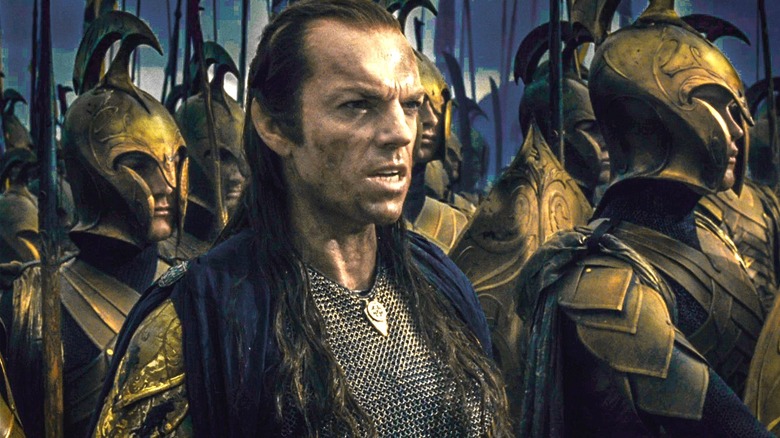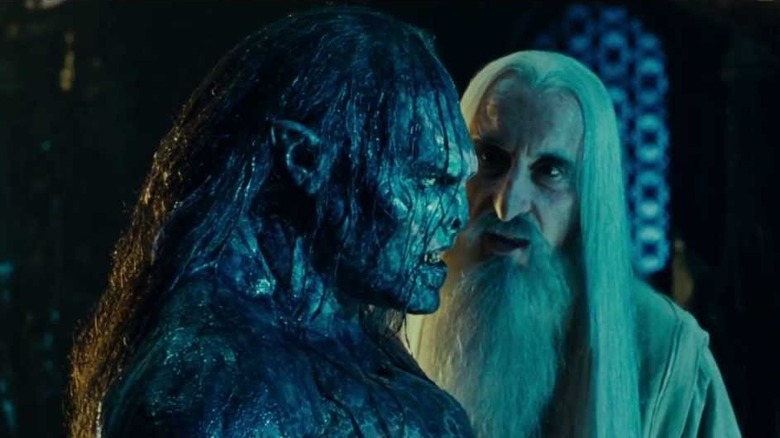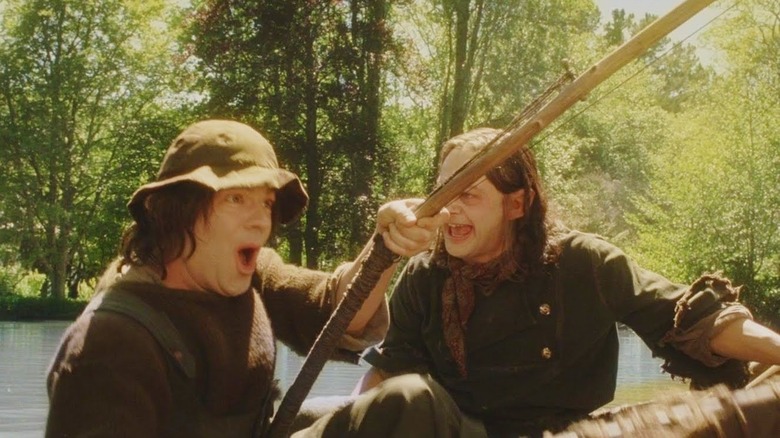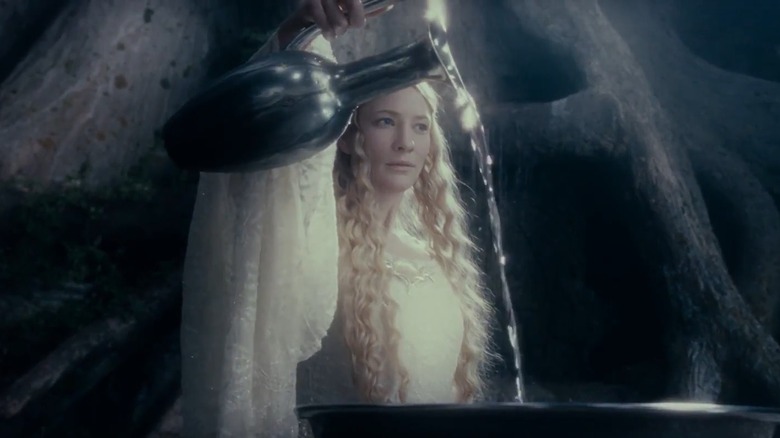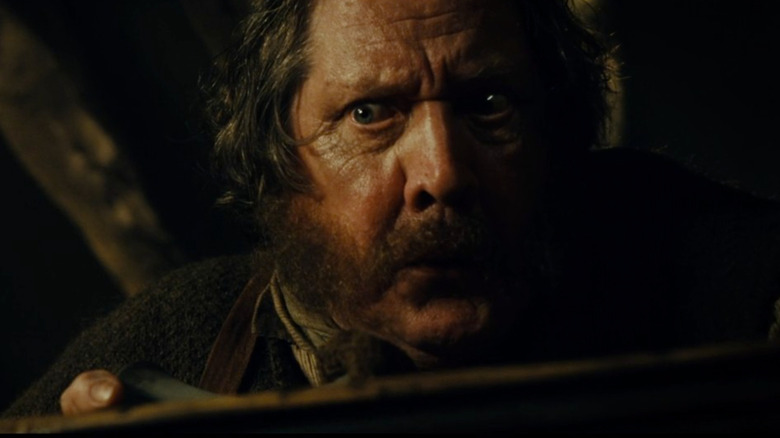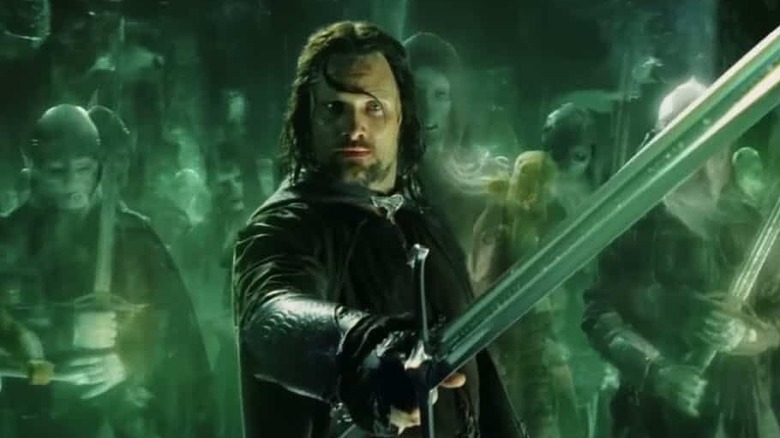5 Lord Of The Rings Facts That Sound Fake But Are Totally True
J.R.R. Tolkien was a proficient world-builder and a master storyteller. Middle-earth sports thoroughly thought-out geographies, clear geo-political nations, and a history that more-or-less coherently stretches back to the dawn of time. When writing "The Lord of the Rings," Tolkien was particularly committed to consistency in the narrative. He tended to everything from linguistics to genealogies, locations, motivations, and more. He even considered how far his characters could travel in a day — writing in a 1954 letter that "I wisely started with a map, and made the story fit (generally with meticulous care for distances)."
This careful attention to detail is what gives Middle-earth its life-like realism, even if it's filled with Elves and Orcs and Wizards. Tolkien's massive compendium of fastidious fantasy lore always considers the realistic behavior of its inhabitants and what it takes to keep people engaged without forcing them into a state of suspended disbelief.
And yet, we're still talking about a made-up world filled with magic and monsters. There are plenty of points where fans are faced with facts that seem less than probable. Are Hobbits really related to Men? How do the seeing stones work? What is the point of the Rings of Power? Knowing that Tolkien oversaw their creation makes it easier to simply take most of these items at face value, and yet they still require some heavy thinking. Here are five canon facts from "The Lord of the Rings" story, in particular, that appear so outlandish they sound fake at first glance — even if they're totally true.
The Uruk-hai might be half-human
In Peter Jackson's adaptation of "The Lord of the Rings," the Uruk-hai have a clear genesis. They are a unique creation bred by Saruman in the pits of Orthanc. We even see them emerging from the mud and filth. This draws on some of the earliest Middle-earth Orc origin stories that Tolkien wrote, where he simply has his Orcish villains emerging from subterranean slime and heat.
However, the author abandoned that version of the Orcs' genesis pretty early on, opting for a more devious evolution — one that at various times included either Men or Elves. And in the case of the Uruk-hai, it's probably the latter.
The term "Uruk" refers to a particularly nasty form of Orcs. In the appendices to "The Return of the King," it says that roughly 500 years before "The Lord of the Rings," "the race of uruks, black orcs of great strength, first appeared out of Mordor." Half a millennium later, they were commonplace in the Dark Lord's armies.
In the book "The Two Towers," Treebeard voices his suspicions about Saruman's diabolical dabbling in Uruk-inspired racial cross-breeding, saying, "He has been doing something to [the Orcs]; something dangerous. For these Isengarders are more like wicked Men." He goes on to surmise, "Are they Men he has ruined, or has he blended the races of Orcs and Men? That would be a black evil!"
A bit later, we also get a conversation during the battle of Helm's Deep where a Rohirric officer says, "But these creatures of Isengard, these half-orcs and goblin-men that the foul craft of Saruman has bred, they will not quail at the sun." While we never get a definitive answer, Tolkien's writings strongly hint at the possibility that the Uruk-hai aren't mud-born monsters. They're half-bred humans.
Hobbits genuinely hate water
Hobbits are a timid race. The heroics of Frodo, Merry, Pippin, and Sam stand out partly because their fellow Halflings aren't just terrified of common enemies, like Orcs and Trolls, but Elves and Men, too. While their inherent timidity is made clear in the movies, only fans of the books know that most Hobbits also have a petrifying fear of water. Sure, they drink the stuff, but toss them in a river or a deep pond, and they're as good as dead.
Early in the book "The Fellowship of the Ring," we find out that Frodo's parents tragically die during a boating accident — both drowned. The Hobbits listening to the tale make it abundantly clear that their willingness to fool around with boating in the first place was a rookie mistake.
Similarly, when the Fellowship of the Ring leaves Lothlórien in Elven boats, the text goes out of its way to describe Sam thusly, "Sam sat in the bows, clutching the sides, and looking back wistfully to the shore."
Merry Brandybuck's very large extended family is considered a peculiar group of Hobbits living on the edge of the Shire. "The Fellowship of the Ring" book explains the main distinction between them and other Halflings, saying they were generally the same, "Except in one point: they were fond of boats, and some of them could swim."
This little piece of Hobbit knowledge makes one act, in particular, even more important. When Sam throws himself into the water as he tries to chase down Frodo at the end of "The Fellowship of the Ring," he isn't just being reckless. He's facing a crippling fear of the aquatic — which is just another reason why Sam is one of the greatest heroes in all of fantasy lore.
Galadriel is as mature as a 93-year-old human in Lord of the Rings
Tolkien was a perfectionist. The Oxford Professor even spent countless hours grappling with the concept of — get this — Elvish aging. While we casually refer to Middle-earth Elves as immortal, the truth is they do mature, albeit slowly. Tolkien came up with different formulas that tried to make sense of this process, and in the book "The Nature of Middle-Earth," he gives us enough information to calculate roughly how mature Galadriel may have been during "The Lord of the Rings."
The basic idea is that Elves in Middle-earth tend to age relatively quickly early in their lives as their bodies physically mature. After that, they aged at a rate of 100 to 1 compared to humans. In the passage of the book titled "Aging of Elves," Tolkien explains that Galadriel had just passed maturity when she arrived in Middle-earth. The text says, "She was therefore 22 on entry into Beleriand and then lived at a 100:1 rate. At the ruin of Beleriand in MY 590 she was therefore about 28."
"The Lord of the Rings" takes place two ages after this. The Second Age is approximately 3,500 years long, and the Third Age is just over 3,000 years long. Add them together and then divide them by 100, and you get 65. Add that to the original 28, and, at least according to this formula, Galadriel has matured to the ripe old age of 93 by the time of "The Lord of the Rings." Of course, that's just one model that Tolkien explored, but it does help explain why Galadriel is more hot-headed earlier in the stories and has become a calm, veteran leader by the time Frodo meets her in Lothlórien.
The village of Bree is older than Elrond — and has Hobbit inhabitants
Elrond is an old dude. By the time of "The Lord of the Rings," he's well over six thousand years old. When you live that long, most physical structures and cities fade away and are replaced by new models. But there's one unassuming little hamlet ensconced away up near the Shire that is actually older than the Elvish counselor by the time Frodo and his Hobbit companions show up for a pint. That's right. The village of Bree is older than Elrond.
"The Fellowship of the Ring" book introduces the Men of Bree by saying, "According to their own tales they were the original inhabitants and were the descendants of the first Men that ever wandered into the West of the middle-world." It goes on to explain, "Few had survived the turmoils of the Elder Days; but when the Kings returned again over the Great Sea they had found the Bree-men still there, and they were still there now, when the memory of the old Kings had faded into the grass."
This plucky little Human town dates back to the Elder Days (code for the First Age of Middle-earth and earlier). In comparison, Elrond is born a half-century before the Elder Days end. While we don't technically have a founding date for Bree, for all intents and purposes, the settlement appears to be significantly older than Elrond himself.
Oh, and did we mention that it has Hobbits, too? Peter Jackson's depiction of the town is a dingy, Man-ridden dump. However, Tolkien's original version is a bit cleaner and more encouraging. Bree is also the only place in Middle-earth where Men and Hobbits (the Big People and Little People, respectively) live in harmony together.
Elrond, Arwen, and even Aragorn are part angel
In general, most of Tolkien's races marry and reproduce internally. Hooking up with someone from another group is frowned upon, and the marriage of Aragorn and Arwen is extremely unique in Middle-earth history. Technically speaking, though, they aren't the only Human/Elvish marriage. At two different points, both of their ancestries (they're distantly related) include a Man marrying an Elf-woman. These are technically the only three official times Tolkien records Humans and Elves getting hitched, and they all take place in the same family tree, which includes a ton of famous folk.
The curveball is that the half-elven offspring isn't the craziest part of this utterly unique genealogical group. That comes way back at the beginning, when an Elvish royal ancestor marries an angel. Early in Middle-earth history, the Elvish king Thingol meets, falls in love with, and marries a lovely gal named Melian. Melian is a Maiar, a race of spirits that help oversee the affairs of the world on behalf of its Creator. Some Maiar are more powerful than others, and some are corrupt, like Sauron and the Balrog. The Five Wizards are also Maiar in physical bodies. In the book "Unfinished Tales," Tolkien describes the Maiar by saying they are "persons of the 'angelic order," adding, "The Maiar were 'spirits', but capable of self-incarnation, and could take 'humane' (especially Elvish) forms."
Melian takes on a physical, humanoid form and marries her hunky Elvish royal. They have a daughter named Lúthien, who meets and falls in love with a mortal named Beren. From there, the family history is off to the races. Eventually, Elrond shows up, and Galadriel's daughter marries into the family — a family with the singular characteristic that each blood-related member is part angel.
